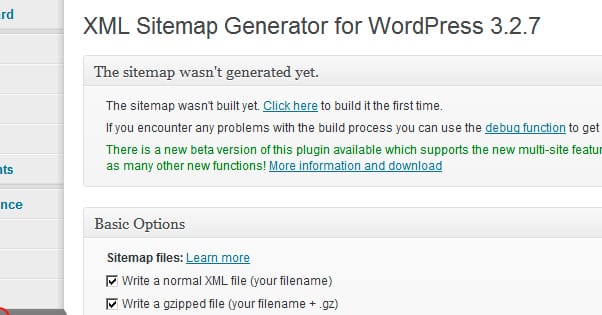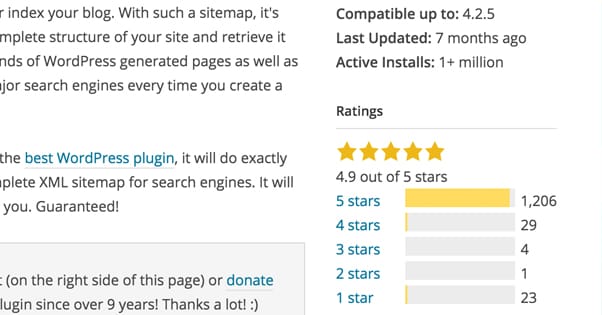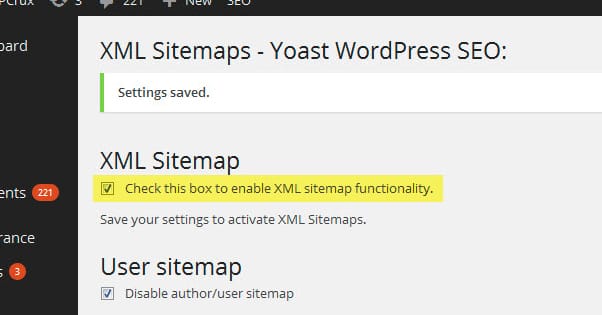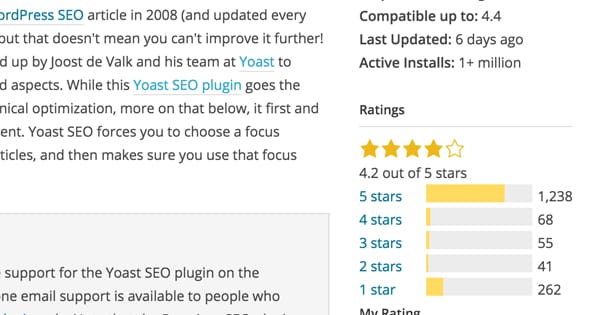Yoast SEO Sitemap vs Google XML Sitemaps Plugin
Published by Kenny Novak • Search Engine Optimization • Posted December 8, 2015 ContentPowered.com
ContentPowered.com
If you search for Sitemaps on WordPress, the number one result you’re going to find is the Google XML Sitemaps plugin. You can find it here. However, it’s maybe not always the best option. Did you know that Yoast’s SEO plugin, even the free version, now has XML sitemap functionality? It’s actually quite robust, and might even be more ideal for many people that the highly rated Google sitemaps plugin.
So, let’s compare the two, shall we?
Creating Sitemaps
Both of these plugins have the easy ability to create a total sitemap of your WordPress blog. It’s pretty simple, really. You run the plugin and it scans your blog for the URLs of all of your posts and, optionally, other content like pages, custom posts, or category pages.
These are not the only way of generating a sitemap on WordPress, they’re just exceptionally easy ways of doing it, because they’re plugins. Other apps require different access or a manual scan, and that can be difficult to grant on a WordPress blog.
I’m sure at this point you already know what a sitemap is, but in case you don’t and you stumbled on this post randomly, like someone crawling out of the desert after 50 years struggling for a hint of a blog, I’ll explain. A sitemap is nothing more than a list of links to all of the pages on your site. More robust sitemaps include some extra data, including when the page was last changed, how often the page is expected to change, and what sort of priority Google might want to use to determine how often to crawl the page to check for changes.
Effectively, a sitemap just exists to tell Google how to crawl your site. It helps you index pages that are otherwise orphaned, or pages that don’t change frequently, or pages that are new. It also helps you minimize the amount of time Google spends crawling pages that haven’t changed; Google can check the change date and compare it to their index, and if they have crawled it more recently than the change date, they don’t need to crawl it again. That’s not to say they won’t, but it minimizes the extra work they do.
An XML sitemap is one of two styles, the other being an HTML sitemap. XML sitemaps are just code, readable by Google but not really made for human consumption. An XML sitemap will look something like this.
An HMTL sitemap, by contrast, shows all of the same data but is made to look more like a webpage, with styles and navigation and whatever else you want to add. It’s essentially a way of taking the same data and turning it into a user-focused table of contents. These are a little less useful to Google, though, and not really recommended for users either. Very rarely will such a table of contents be manageable as you grow your site, and users don’t expect them in the first place. Just stick with the XML sitemap.
Google XML Sitemaps Plugin
The Google XML sitemaps plugin is a WordPress plugin specifically designed to make an XML sitemap, readable by Google and other search engines, with a complete index of your site. Though the name might imply it, it’s not produced by Google; rather, a man named Arne Brachhold made it. Arne is a very talented developer, but he’s still just one man, and as such the plugin has a few issues. More on those later, though.
As of the time of this writing, the Google XML Sitemaps plugin has been downloaded over a million times and has a 4.9 out of 5 star rating. 1,191 reviews are 5-stars, and only 57 reviews of any other star level. For a WordPress plugin, this is stunningly high for a rating.
Also, despite the name, this plugin is not limited to just Google. An XML sitemap is an XML sitemap, regardless of how it was created, and is readable by any search engine that cares to read. That means Google, Bing, Yahoo, and anything else that finds the map. You can, of course, submit the sitemap directly to these search engines through their webmaster tools menus.
The Google XML Sitemaps plugin has a lot of options. You can:
- Set the priority of the page for indexation. This tells Google and the other search engines how much importance they should give to indexing the page, if they have limited time or the site is slow. A priority of 1 is a good rating for homepages, something like .6 for posts, and down to .3 or lower for tags and author pages.
- Set the priority of each post for automatic calculation. You can have each post dynamically change priority based on the number of comments or the average comment count, or disable it and use a flat priority.
- Exclude specific types of posts or post categories. This is useful if you have a category of posts for personal stuff you would prefer isn’t indexed.
- Select which categories of content are included in the sitemap from a list that includes homepage, posts, static pages, categories, archives, author pages, tag pages, and the optional last modification time.
- Allows you to specify exact URLs you would want to include in the sitemap, but which are not themselves typical URLs on your blog.
- Automatically submit the sitemap to major search engines when generated.
- Set specific change frequencies for different categories and types of pages.
All of this is very robust control over your sitemap; it basically does everything you could potentially want it to do for you. At least, within the realm of sitemaps it does.
Google XML Sitemaps is not completely flawless, however. For one thing, it hasn’t been updated in seven months as of the time of this writing. That means it could potentially have an unpatched security hole, or even just not be compatible with some more recent plugin updates. It has also only solved two out of 27 support threads in that time. It has some rare code errors that might require fixing manually, and there are some reports that it causes issues with indexing images.
Also, if you use some of the permissions in the plugin, it creates a virtual robots.txt file to use. This will cause issues if you have your own robots.txt file, and it’s not easy to edit the virtual version to include content not specified by the sitemap plugin itself. This means if you want to use your own custom robots.txt directives, you’ll need to avoid using those features in the plugin.
Yoast SEO’s Sitemaps
Yoast is a very high profile WordPress developer. The man behind the brand is Joost de Valk, and the Yoast family of plugins have been highly prominent since 2008 or earlier. Yoast SEO is perhaps his best-known offering, because it’s a very robust and highly detailed general SEO plugin.
So, there’s the number one difference between Google XML Sitemaps and Yoast SEO. Yoast is a full, broad-spectrum SEO plugin, with a lot more features than just the sitemaps. In addition to sitemaps, it does:
- Complete control over meta titles and descriptions, including a content analysis that includes thirteen points it checks to consider whether or not the meta data you enter is as optimized as it can possibly be.
- Configuration options for robots.txt on a per-page basis, rather than lumping everything in one file. This is at one more granular because you can set it directly on the page, but easier to manage because it’s all handled from one central dashboard.
- Canonicalization support to help minimize accidental copied content on you rsite, or across multisites.
- Breadcrumb code that is often used in other WordPress themes and gives you a lot of control over taxonomies and what is visible in the breadcrumbs.
- Permalink cleanup options to minimize URL parameters and variables that cause URL issues.
- RSS management, including different links for the blog in general and for the specific post.
- An API for more customizable access if you’re a developer.
The sitemaps, of course, are the primary selling point here. Whether or not the rest of the SEO features are a selling point depends on you. If you care about SEO – and if you don’t, you wouldn’t be looking for sitemaps – you might greatly appreciate a lot of those additional features. On the other hand, you might already have another plugin, like All-In-One, to manage your other general SEO needs.
Yoast SEO’s plugin is a little more controversial in terms of ratings on WordPress itself. It also has over a million installs, but it only has 4.3 out of 5 stars. 1,226 of the reviews are 5-star, and the rest combined total up 343. Of those, 189 of them are 1-star reviews, which doesn’t necessarily bode well. Then again, with any prominent and highly detailed plugin, there are bound to be people who don’t know how to use it, who have conflicts and blame the plugin, or just expect it to be a lot easier to use than it is, and take it out in the reviews.
Of course, Yoast also doesn’t have a high track record with support threads. In the last two months, the support board has 614 open support threads, of which 151 have been resolved. That’s still only 1 in 4. Then again, the plugin was updated three days ago as of this writing, so it’s at least more actively supported than Google XML Sitemaps.
Yoast has one very interesting bit of functionality that Google supports. That function is sub-sitemaps. When your site gets too large and sprawling, it can take a long time to generate and load an XML sitemap. Sub-sitemaps are created for every 1,000 posts in a given category. Each individual sub-sitemap is linked from the main sitemap, giving Google easy access to the entire directory.
Yoast also includes XSL stylesheets, which make an XML sitemap readable to humans as well as to Google. It’s sort of a cross between XML functionality and HTML display utility. If you want to use your sitemap as a directory for actual readers, this would be the way to do it, though I doubt it’s really that useful. Up to you, of course.
Yoast has a few issues, though.
- If you’re using the default WordPress permalink structure, it won’t work. Flat out. The entire thing breaks and just displays a 404. Granted, you shouldn’t be using the terrible default permalinks in the first place, but still. It’d be nice if there was some warning, rather than this being an esoteric bit of knowledge you only know if you pay attention.
- It has a very scary warning about compatibility with Google XML Sitemaps, implying that if you try to use it with Yoast – even with Yoast’s sitemap features turned off – everything will break. This isn’t true; the warning only applies if you’re trying to use both sitemap plugins simultaneously.
- Some people report Yoast adding a prominent link to itself within your sitemap. This is a somewhat shady action on their part and is a huge boost to their SEO with no way for you to remove it.
All of these are minor issues, all things considered. You can work around them fairly easily, and Yoast comes with so many benefits that it’s really quite worth the effort. Yoast also does not have any reported failures to index images, which is good.
Both Yoast and Google XML Sitemaps have different structures for their sitemaps. Yoast uses sub-sitemaps divided by category, with up to 1,000 links in each sub-map. Google XML Sitemaps does do these sub-sitemaps as well, but rather than stacking them up per category, I twill divide them up chronologically by archive date. Each monthly archive gets its own sub-sitemap. This may lead to a lot of individual sitemap files, which can look cluttered. However, to Google, there’s not really a difference between them functionally. A lot of little files or a few large files both work the same way, and Google has no trouble with either method.
One concern I can alleviate here is search engine integration. Both Yoast and Google XML Sitemaps will submit your sitemap to all of the major search engines, not just Google.
Alternatives
In addition to Yoast and Google XML Sitemaps, there are other sitemap plugins you can use. I mentioned All in One as an SEO alternative to Yoast, and it does sitemaps as well. It’s perhaps the most comparable alternative to Yoast, but again, it’s overkill if all you need is a simple sitemap app.
Another alternative is the Better WordPress Google XML Sitemaps plugin by Odd One Out. It’s very much like Google XML Sitemaps, except ti also supports Google News sitemapping. It’s also useful for working with WordPress Multisite, if you’re running numerous blogs and want one dedicated sitemap indexing site sitemaps.
If all of these are a bit much and you don’t really care about any of the deeper configuration options, all you need to do is use Denis de Bernardy’s XML Sitemap plugin. It’s basic, it’s functional, and it doesn’t bother you with advanced configuration or crazy options.
Conclusion
If you want a deep, robust SEO suite that happens to include site mapping, you have the choice between Yoast and All in One. We’ve talked about them before, and they’re both part of our recommended new site plugins list. Personally, we use Yoast on all of our websites, and have uninstalled Google XML Sitemaps.
If you want a super basic sitemap utility, you can use Denis’ version, or you can even use a third party web app to generate one every couple of months. It’s up to you.
If you want something middle of the road between them, pick up Google XML Sitemaps. It’s just the right middle ground between functionality and simplicity. Make your choice, and make it well; it might take you as much as 20 minutes to change if you change your mind!










Yoast is not adding the separate html pages in root to the sitemap. Any solution?
Hi Indresh! Yoast adds an XML sitemap. HTML sitemaps are different, and optional, but XML sitemap is important for indexing for search engines. You can add an HTML sitemap if you prefer to have one, but it is somewhat deprecated in 2019.
nice article and i like it but how if i am want to use plugin and i hope u can next time make new article about making sitemap with plugin, it will be nice too. thanks from susugede.net